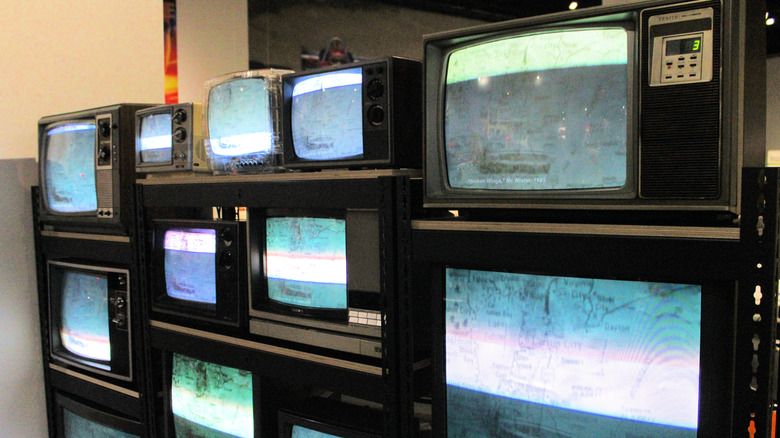Why Using Glass Cleaner On Your TV Is Never A Good Idea
Oops. There's a good chance you've been cleaning the screen on your newer flat-screen TV the wrong way for years. Especially if you come from the era when they were made solely of glass and devoid of any fancy plastic layer or special anti-glare coating.
For the longest time, TVs were made using cathode ray tubes (aka CRTs), which in simplest terms was a vacuum tube containing one or more electron guns that projected images onto a fluorescent screen. The curved and bulbous face of those screens was made using thick, heavy, shatter-resistant glass to block X-ray emissions — another reason your parents didn't want you to sit too close to the TV. Back then, screens didn't have any protective outer layers, plastic or otherwise, so cleaning them with glass cleaner was not only practical but expected.
When the digital age exploded in the early 2000s, our TVs morphed into high-tech viewports, complete with wide, flat screens featuring plasma, LCD, and OLED technology, replete with special coatings and glare-reducing features. If you use those same glass cleaners of old now, they'll do infinitely more harm than good. According to virtually every television maker today, you should never use things like standard window cleaners, scouring powder, soaps, alcohol, benzene, ammonia, etc. Doing so could result in permanent damage to the screen. Even pressing too hard to remove a stubborn smudge could cause the liquid crystals to collapse. What's more, using items with rough fibers, like paper towels or tissues, can create scratches, but there is a proper (and easy) way to clean your flat-screen TV.
TV screens need to be handled with care
The solvents in most glass cleaners, such as ammonia, benzene, or alcohol, could, erode the anti-glare coating over time and leave permanent marks on the screen. They can also cause the screen to take on a yellowish hue or look foggy. Believe it or not, the first television hit the market all the way back in 1929. Approximately one thousand of these Baird Televisors were sold, and the screen, if you can call it that, was roughly postage-stamp-sized, so a quick wipe with a damp handkerchief was all it took to clean that minuscule monitor.
Several significant advancements have occurred in the history of television. However, the economic boom that followed World War II – often referred to as "The Golden Age of Capitalism" – brought with it an exponential surge in technology and, subsequently, an increase in television ownership. In 1946, network broadcast service was still limited to densely populated U.S. metropolitan areas, and ownership was thought to only be a few thousand.
The advent of new technologies not only brought prices down but also expanded broadcast service. By 1949, people were buying as many as 100,000 televisions each and every week. A year later, the first remote control was sold, and the number of TVs in use grew to 6 million. The first color television broadcast was made in 1953, and by 1959, over fifty million televisions sat in households. That's a lot of people vigorously cleaning glass screens over a long period ... a bad habit that has stuck with many, even today.

